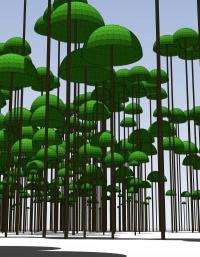Seeing the tree from the forest: Predicting the future of plant communities

The ability to envisage the future may be closer than you would think. A recent paper by Sean Hammond and Karl Niklas in the August 2009 issue of the American Journal of Botany presents an algorithm that may be used to predict the future dynamics of plant communities, an increasingly interesting area of study as significant environmental changes, such as global climate change and invasive species, are affecting current plant communities.
Similar ecological factors, such as nutrient availability and habitat stability, play a role in the growth and development of both an individual plant and a community of plants, like a forest; however, the length of time that these factors effect change differs between individual plants that may live for decades and plant communities that may exist for thousands of years. A goal of plant ecology has been to find ways to predict plant behavior in communities based on observed properties of a few representative members.
Hammond and Niklas have developed an algorithm—spatially explicit, reiterative algorithm, or SERA—that explores whether changes occurring in plant communities, such as self-thinning and the competitive displacement of one species by another, can be attributed to the characteristics of the individual plants that comprise the community.
"Our model predicts how a plant population or community will behave when plant-plant interactions are predicated exclusively on the constraints imposed by a few physical principles and by competition for physical space and light," stated Dr. Niklas.
Recent empirical studies have shown that a variety of plant communities in different environments exhibit some of the same size-dependent and age-dependent trends. One example is the relationship between the mass of tree canopies and the diameter of the tree trunks. In the simulations of plant growth within a community performed by SERA, various trends emerged as a result of competition for light and space among the individual plants, and these trends are in agreement with the trends found empirically in plant populations.
Other results of SERA simulations were also found to be in agreement with empirical data. Although a few million years late, SERA predicted that angiosperms would outcompete gymnosperms as the dominant land plants, and it was able to accurately predict the age at which a variety of plant species would reach reproductive maturity.
"Remarkably, our model predicts the behavior of real plant populations, and thus suggests to us that many 'complex' ecological interactions emerge as a result of a few very 'simple' processes," commented Dr. Niklas. SERA may be very useful in predicting changes in community development and composition as environmental and climatic variability increases.
More information: The full article is available for no charge for 30 days following the date of this summary at www.amjbot.org/cgi/content/full/96/8/1430 .
Source: American Journal of Botany















